
Kenny Jarrett built two 358 STA rifles in 1991 on blue-printed Remington 700 actions, this one for Layne and another quite like it for Bob Nosler. This rifle has a Lilja 24-inch No. 4 contour barrel with a 1:12 twist and a Griffin & Howe style stock made by McMillan.
Norma of Sweden developed the 358 Magnum specifically for the American market and introduced it in 1959. The initial publicity it received was mostly positive. Nils Kvale, who was head of the design department at Norma, had friends in important positions with more than one American ammunition company, and rumor had it that several 338 Winchester Magnum cases were on hand while he was designing his 358 Magnum. Whether or not that was true will probably never be substantiated, but the dimensions of the two cases are close enough to allow the Norma-designed case to be formed by necking up the case designed by Winchester with no fire-forming required.
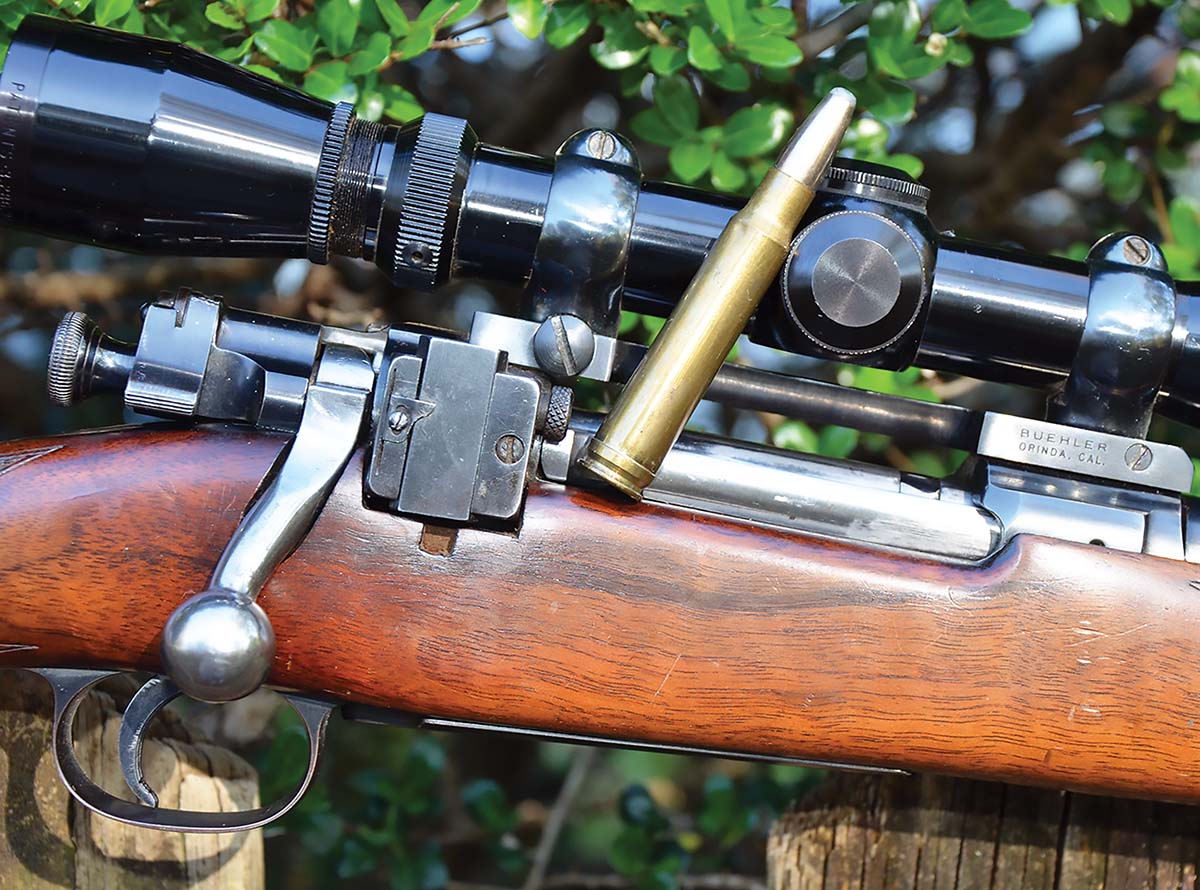
When the 358 Norma Magnum was introduced to the American market, gunsmiths across the country were busy building rifles around the 1903 Springfield action (shown here) and Mauser 1898 actions, which were quite affordable on the military surplus market. Since the overall length of the Norma cartridge was the same as for the 30-06, a few modifications made to those actions made them suitable for handling the new cartridge.
Various wildcatters had created a number of big thirty-fives through the years, but no commercially loaded version had been available to American hunters since Winchester-Western discontinued loading the 35 Newton and 350 Griffin & Howe Magnum sometime during the 1940s. When the 358 Norma Magnum came on the scene, 1903 Springfield and 1898 Mauser rifles were both abundant and affordable on the military surplus market and gunsmiths across the country were building rifles around them. Realizing its new .35-caliber cartridge was short enough to be squeezed into those actions, Norma did nothing more than send chamber reamer dimensions and unprimed cases to the American market and then waited for dollars to begin pouring in. The big payoff never came. While quite a few rifles were probably built around the 1903 and 1898 actions, the cartridge was destined to failure simply because no American manufacturer was offering a rifle chambered for it. Besides, why go to the trouble of having a rifle put together for a cartridge unavailable in factory-loaded form when plenty of Winchester 70s and Remington 700s in 338 Winchester Magnum were waiting for new owners in gun stores across the country?
Then, a narrow ray of bright sunshine beamed through dark clouds hovering over the big Norma cartridge. Beginning around 1980, Federal became the sole distributor of Norma ammunition in the United States, with about 25 cartridges ranging from the 222 Remington to the 9.3x62mm Mauser on the availability list. Mike Bussard, who worked for Federal at the time, called in 1987 to inform me that the 358 Norma Magnum loaded with a 250-grain bullet at 2,790 feet per second (fps) would be added during late 1988 or early 1989, but in the meantime, would I be interested in hunting moose in Sweden as a guest of Norma later in the year? I immediately decided that using the 358 Norma Magnum on that hunt was the polite thing to do, but where would I find a rifle chambered for it? Another friend by the name of Melvin Forbes, who owned Ultra Light Arms, answered the question by putting together a Model 28 with a 24-inch barrel chambered for the cartridge.
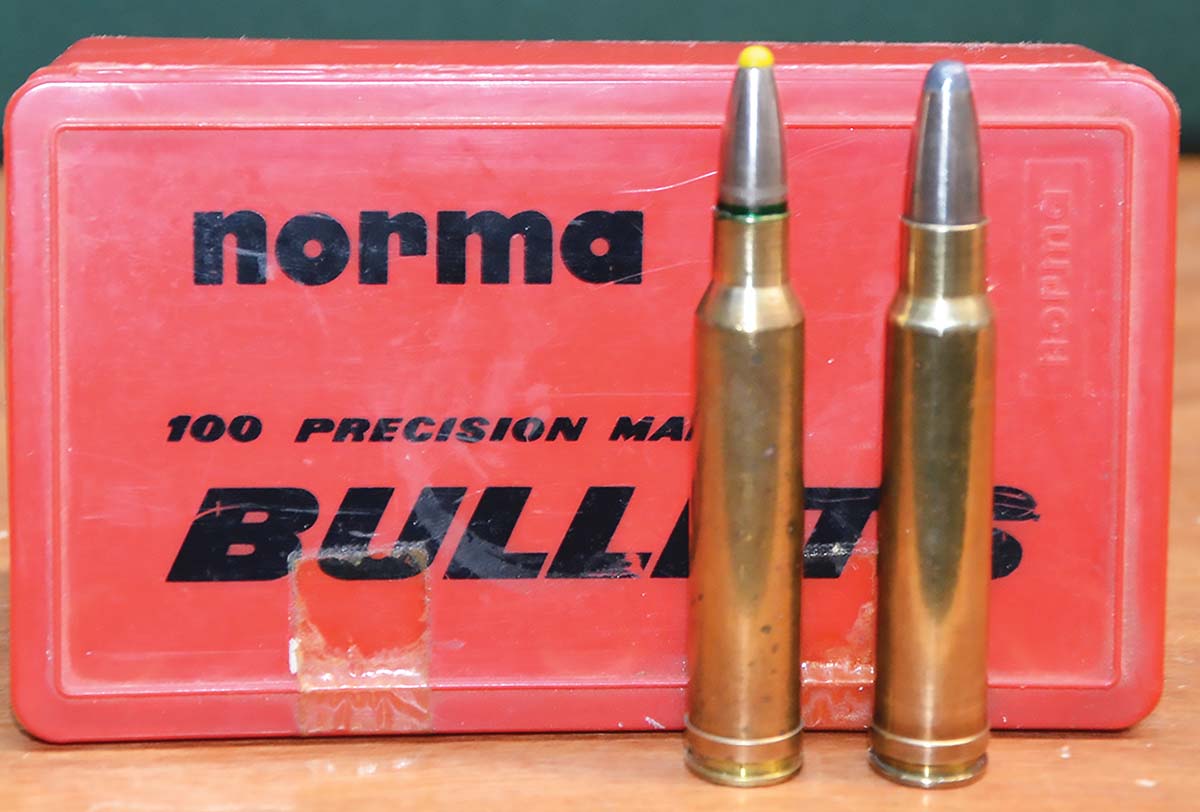
Norma introduced the 308 Magnum (left) and the 358 Magnum (right) in 1959. Due to lack of factory-loaded ammunition and rifles chambered for them by American manufacturers, neither became successful among American hunters. Stiff competition from the 338 Winchester Magnum was introduced in 1958, and the 300 Winchester Magnum (1963) represented additional nails in their coffins.
Factory ammunition would not become available until more than a year after the hunt so I decided to duplicate the factory load as closely as possible by handloading. Cases were formed by using a Redding full-length sizing die with a tapered expander button to neck up Federal 338 Winchester Magnum cases. Federal 215 primers were used. Luck was with me when I found a box of Norma 250-grain bullets gathering dust on the shelf of a local gun shop. A search through my files turned up load data published by Norma during the early 1960s for that bullet and load. One load was 66.3 grains of Norma 202 for a velocity of 2,710 fps at a chamber pressure of 53,400 pounds per square inch (psi). Norma powders were never easy to come by, but my loading room had unopened cans of N201, N202, N204 and N205. Velocity was a bit higher with a maximum charge of N204, but accuracy was not as good.

In addition to making the very first 358 STA die sets, Redding was also quick to offer dies for the 358 Norma Magnum.
Resting on a shelf above those bullets were several boxes of Norma 9.3x62mm Mauser ammunition loaded with a 286-grain bullet measuring .366-inch in diameter. The passage of almost four decades has faded my memory as to why I decided to pull some of those bullets and try them in the 358 Norma Magnum, but with the aid of a bench vise, Imperial case-sizing wax and a couple of Lee bullet sizing dies, I reduced their diameter to .358 inch. A maximum charge of Norma 204 pushed that bullet to 2,600 fps with 3-shot accuracy inside two inches at 100 yards. With about the same burn rate, IMR-4350 worked equally well, although velocity was a bit lower. Considering all that squeezing down, I was surprised to see the Model 28 deliver slightly better accuracy with the 286-grain bullet than with the Norma 250-grain bullet.
On several occasions through the decades, I have shot driven moose with Norma in Sweden and Sako in Finland, and their methods differ quite a bit. In Finland, a line of beaters yelling and making all sorts of noise drive moose through the woods toward the line of guns. When a moose comes into view, its afterburner is usually on full blast. In Sweden, each driver is accompanied by a dog that trails silently, both easing through the woods together. For this reason, when a moose comes by it is not always in quite as big a hurry.
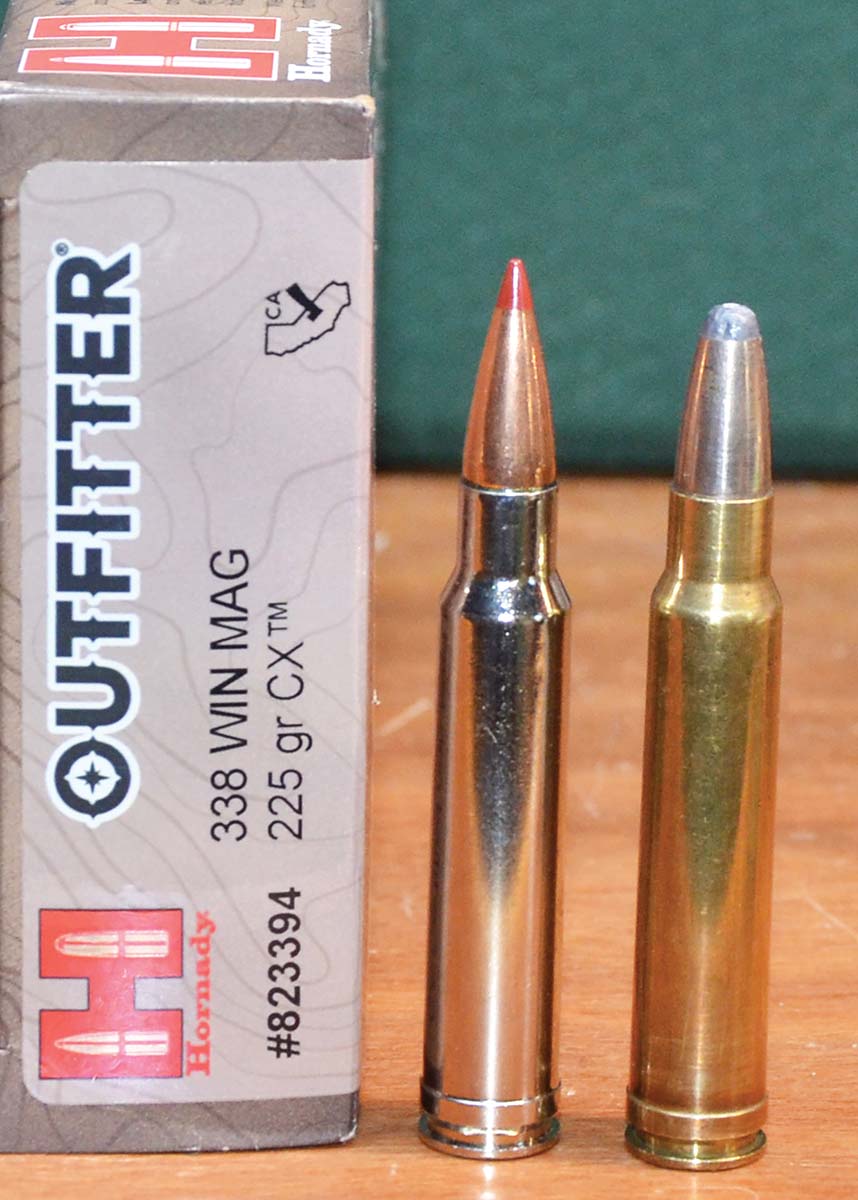
Rumor has it that several 338 Magnum cases made by Winchester were on hand while the 358 Magnum was designed.
My hunt in Sweden with the Ultralight Arms rifle proved to be quite successful. On the third rainy day, I was standing with my shoulder resting against a tree on the edge of a willow-fringed meadow estimated to be about 100 yards long with thick timber standing at each end. The meadow was 250 yards or so wide, with openings among scattered growths of willows and small saplings. The cartridges in my rifleere loaded with the 286-grain bullet. I had already decided there would likely be only a few seconds for a shot, and I was right. As if to test me, a cow and her calf were there and gone rather quickly. Moments later, a “huge bull” (by Swedish standards) came trotting along at a fairly quick pace at about 200 yards from my post. Shouldering the rifle, I quickly swung it through the length of the bull and squeezed the trigger just as the crosshairs of my Bausch & Lomb 1.5-6x scope caught up with about the middle of its neck. As I chambered another round and was swinging the rifle for a possible second shot, the bull stumbled and fell after traveling about 40 yards.
While we were field dressing the bull, Heinrich Bachmann, another hunter standing about 200 yards away, remarked that he had heard my bullet strike, and the sound seemed a bit unusual. His statement, along with what appeared to be an unusually large entrance wound in the moose, prompted me to locate where the animal was when taking my bullet. By looking for any hair the bullet might have clipped from its hide as it entered the body, I located the spot and then looked across the meadow toward the tree I had been standing beside when firing the shot. About 12 yards in front of me and directly in line with where I had stood was a sapling with its trunk blown almost in half. After traveling 200 yards, the 286-grain bullet had blasted through about two inches of live wood and continued on to strike the moose close behind its shoulder. Even though the bullet had started to expand while passing through the sapling, it still retained enough velocity and sectional density to penetrate the bull’s chest cavity and exit the other side. We never recovered the bullet.
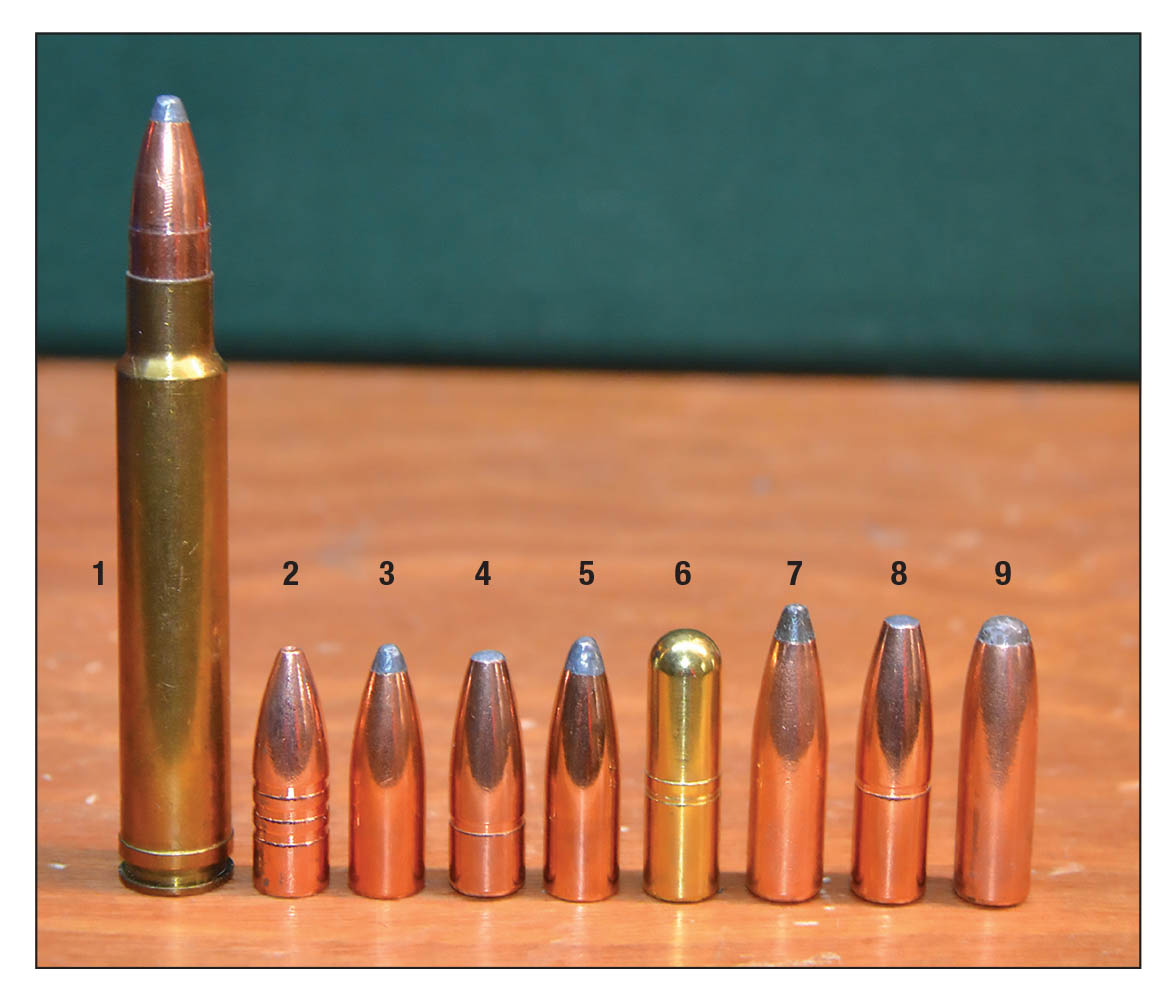
The 35 Newton and 350 Griffin & Howe Magnum were loaded by Winchester until sometime during the 1940s. Griffin & Howe originally formed the 350 Magnum by necking down the 375 H&H Magnum case. Layne created the 358 Shooting Times Alaskan (STA) by necking up the 8mm Remington Magnum case and fire-forming it to less body taper and a 35-degree shoulder angle: (1) 35 Newton, (2) 350 Griffin & Howe and (3) 358 Shooting Times Alaskan.
On the afternoon of that same day, I bagged a second bull but with the Norma 250-grain bullet. As I sat in another drenching downpour overlooking another meadow, the animal decided to trot across at about 220 yards away and as my bullet struck its shoulder, the bull turned back toward thick timber from which it had emerged and traveled about 30 yards before piling up.
On my way back home from Sweden, I made the decision to buy the Model 28 rifle from Melvin Forbes, but it was not to be. A long-time customer who had purchased several rifles from him through the years had learned about me using the rifle in Sweden and ordered one just like it for an upcoming hunt for brown bear in Russia. When Melvin mentioned that, along with the fact that delivering a rifle for one of his best customers in time for his hunt would be extremely difficult, I returned the rifle.
For the next few years, my big-game battery needed a rifle chambered for a magnum-capacity cartridge of .35 caliber. Then, in 1991, I necked up and fire-formed the 8mm Remington Magnum case, and so was born the 358 Shooting Times Alaskan (STA). While the earlier 7mm Shooting Times Westerner had been formed by simply necking down the 8mm Magnum case, the capacity of the 358 STA case was increased a bit by decreasing body taper and increasing the shoulder angle to 35 degrees. The case is also easily formed from 300 H&H and 375 H&H brass. Regardless of the case used, 83.0 grains of IMR-4350 behind a 225-grain bullet or 80.0 grains of the same powder with a 250-grain bullet forms cases nicely. I ended up with a cartridge quite similar to the 350 Magnum introduced by Griffin & Howe many years before.
The first rifle in 358 STA built by Kenny Jarrett was a switch-barrel job on a blue-printed Remington 700 action with an extra barrel in 7mm STW. Clymer made the 358 STA chamber reamer, and Redding was the first to make the reloading dies. Made by Dan Lilja, the 24-inch stainless steel barrel has his No. 4 contour with a muzzle diameter of .670 inch. At the time, Barnes made .35-caliber lead-core bullets weighing 275 and 300 grains, so to make sure they would be stabilized by my rifle, I went with a 1:12 twist rather than the usual 1:16 twist for cartridges of its caliber. Unfortunately, the Griffin & Howe-style stock is no longer available from McMillan. Wearing a Swarovski scope, the rifle weighed 7.75 pounds, and recoil appeared to be about the same as for a slightly heavier rifle in 340 Weatherby Magnum, owned by a friend who was addicted to elk hunting.
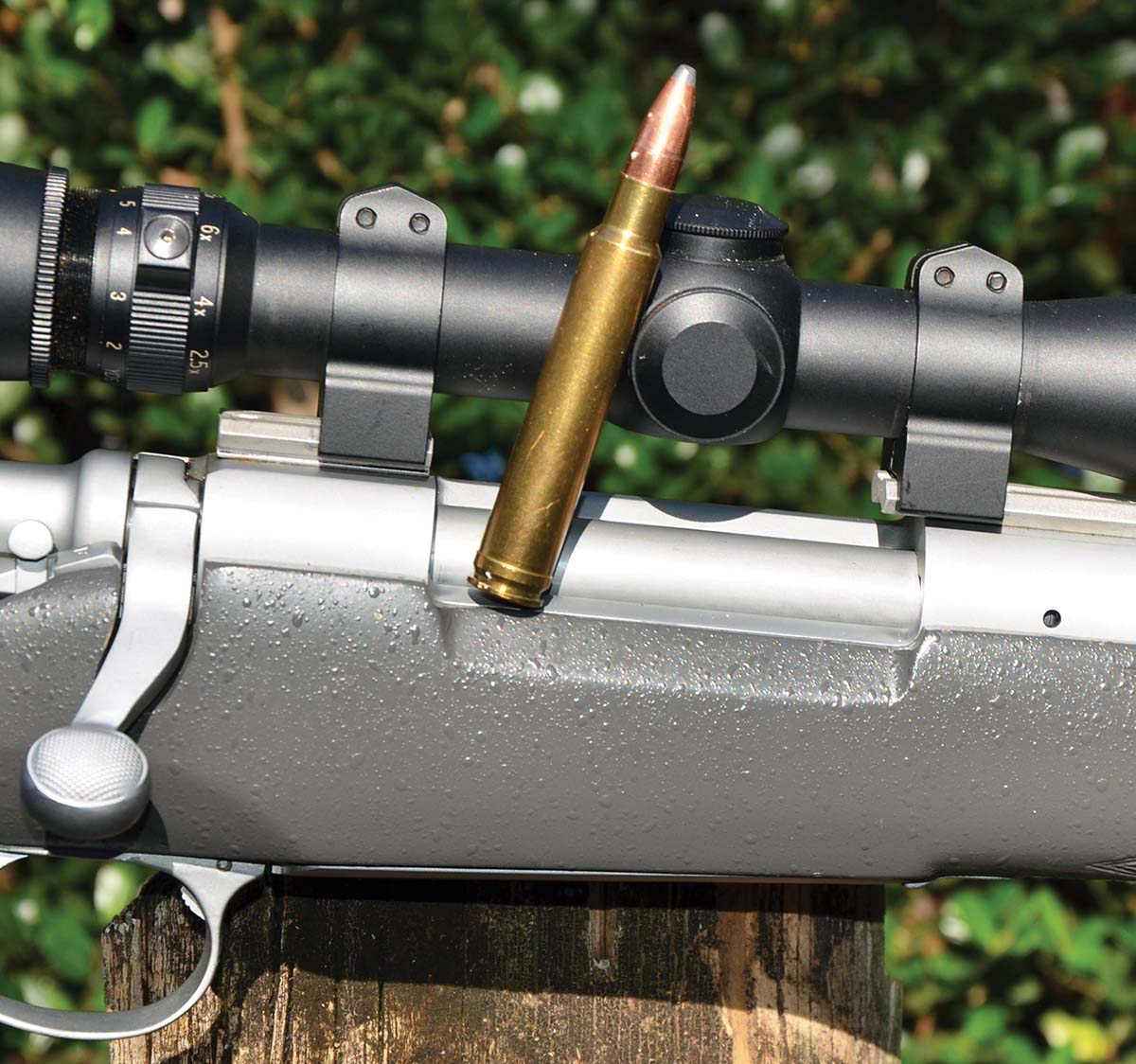
With a nominal overall length of 3.60 inches, the 358 STA requires a long action, such as the Remington Model 700 shown here.
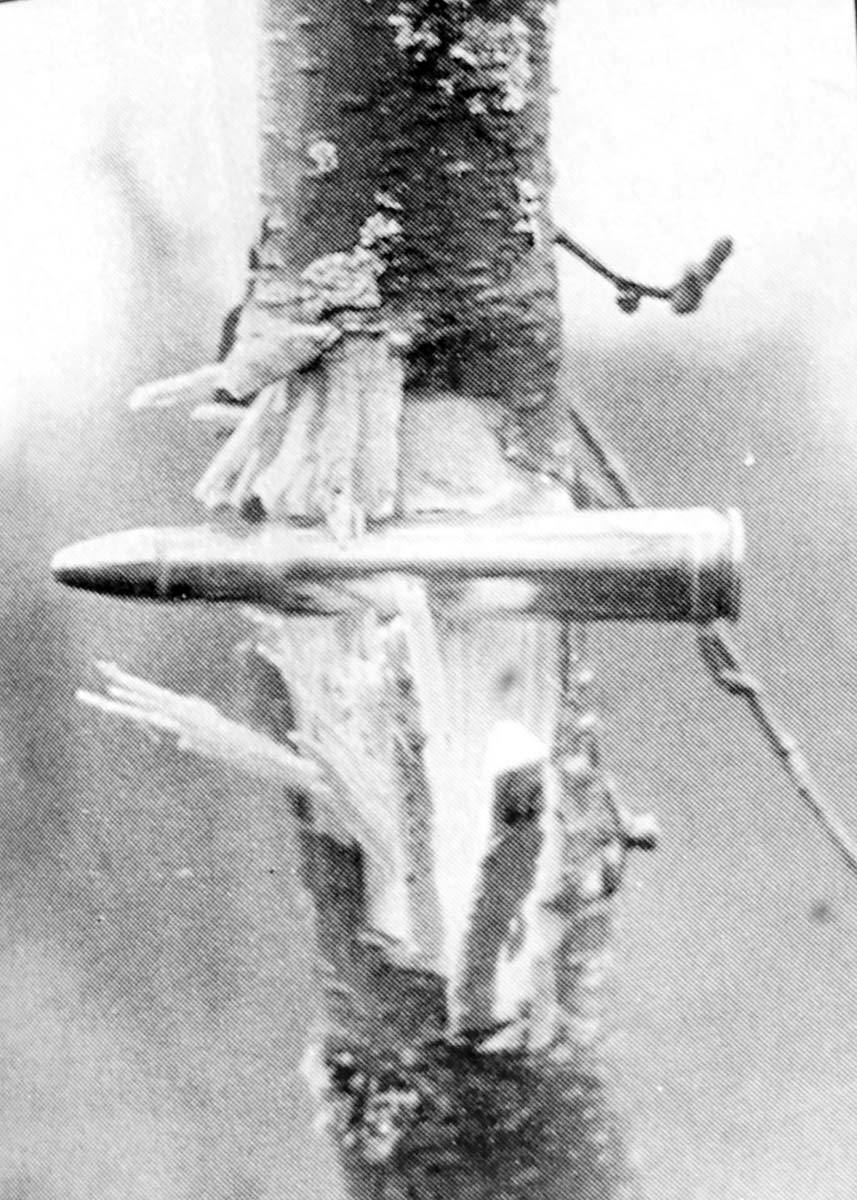
Using a Model 28 rifle in 358 Norma Magnum built by Melvin Forbes Ultra Light Arms, Layne filled two tags, one with the Norma 250-grain bullet, the other with the Norma .366-inch 286-grain bullet drawn down to .358 inch. On its way to the first moose from about 200 yards, the heavier of the two bullets struck this sapling and then traveled on to take the moose just behind the shoulder. To illustrate the size of the sapling, Layne placed a 358 Magnum cartridge, as shown here.
The first game taken with the rifle ended up being my second-best Alaskan brown bear to date, and we spotted it during, you guessed it, a frog-drowning downpour. In fact, it was one of the worst storms I have experienced in Alaska. The scope on my guide’s rifle fogged beyond use, but the Swarvoski on my rifle never noticed the rain. From about 40 yards, a single Nosler 250-grain Partition pushed close to 3,000 fps by 84.0 grains of IMR-4350 ended my hunt. With another hunter arriving in camp the same day as my departure, the guide badly needed a scope for his 375, so he became the proud owner of my precious Swarovski. The second Jarrett rifle in 358 STW went to Bob Nosler, who used that same load to take a very good Alaskan moose. A bit later that same year, Chub Eastman, who worked for Nosler, used Bob’s rifle to take a nice elk in Colorado at 140 yards. Chub used the Nosler 225-grain Partition and 90.0 grains of Reloder 19 for a velocity of 3,120 fps. His bullet struck just behind the shoulder, punched a large cavity through the lungs, and was recovered and expanded against the offside hide. After being shot, the animal stumbled along for about 15 yards and dropped.
Earlier magnum 35s were greatly handicapped by the lack of bullets designed to hold together and penetrate at their impact velocities. This especially held true when taking shots inside 100 yards at game such as elk, moose and the big bears. Then came bullets such as the Nosler 225-grain and 250-grain Partitions, the 250- and 280-grain A-Frame bullets from Swift and Barnes X-Bullets weighing 225 and 250 grains. I never used the Barnes 250-grain solid on game, but am aware of several buffalo taken in Africa and Australia with it. I have also received reports of the old Barnes lead-core bullets weighing 275 and 300 grains as being quite effective on game. Both have been discontinued for quite some time.
How do the 358 STA and 358 Norma compare in velocity? When both were loaded with 250-grain bullets and fired in the 24-inch barrels of my rifles, the 358 STA was in the neighborhood of 200 fps faster. Velocities can vary from rifle to rifle due to slight variations in bore dimensions, so the same comparison made with pressure barrels is usually more accurate. In both the Nosler Reloading Guide 7 and Nosler Reloading Guide 8, maximum velocities for the 250-grain Partition are 2,628 fps for the Norma cartridge and 2,898 fps for the 358 STA, for a difference of 270 fps. Pressure barrel lengths were 24 inches for the Swede and 26 inches for the American.
Let’s move on to the Barnes Reloading Manual 3 and the Barnes Reloading Manual 4, where both cartridges were tested in 24-inch pressure barrels. The maximum velocities for the 250-grain XFB bullet were 2,818 fps for the Norma cartridge and 2,995 fps for the STA for a difference of 177 fps. Data for both cartridges are in the earliest edition of Hodgdon’s annual manual I have, and the scores for Hornady 250-grain bullets read 2,778 fps for the Norma cartridge and 2,984 fps for the STA for a difference of 206 fps.
Whether or not there is enough difference in performance between the two cartridges to matter is for each hunter to decide. Both are powerful enough to handle any big-game on the North American continent and most game anywhere else in the world.








.jpg)


